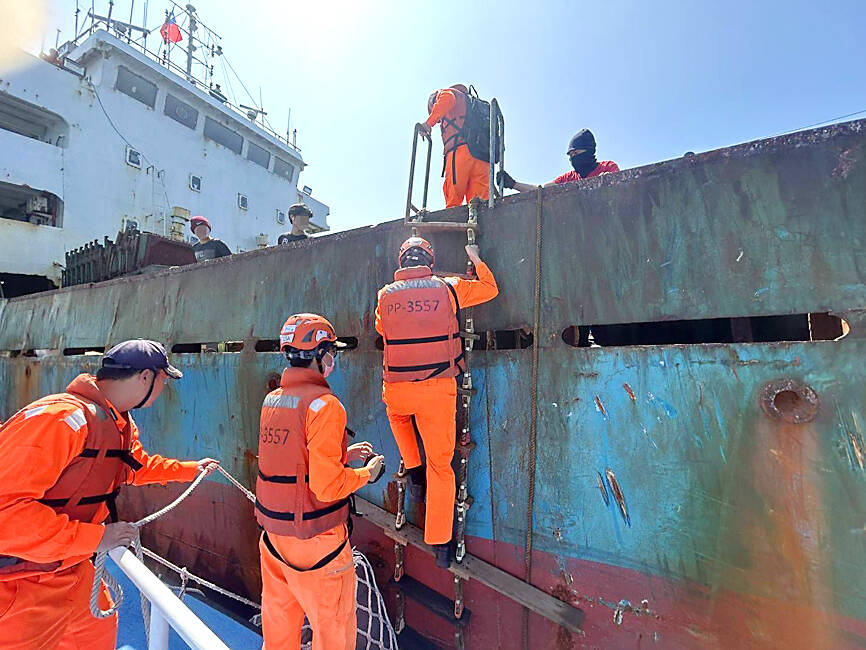China could block undersea cable repair vessels if a conflict across the Taiwan Strait were to occur, which would be a major problem for Taiwan as more than 90 percent of its Internet connectivity depends on submarine cable links, a report by intelligence advisory firm Recorded Future said.
The report, titled “Submarine Cables Face Increasing Threats Amid Geopolitical Tensions and Limited Repair Capacity,” was released by Recorded Future’s intelligence research unit Insikt Group on Thursday last week.
Insikt said its conclusion was based on an analysis of recent territorial conflicts between China and the Philippines in the South China Sea, where the China Coast Guard has tried to block Philippine resupply operations to vessels at the Second Thomas Shoal (Renai Shoal, 仁愛暗沙), Scarborough Shoal (Huangyan Island, 黃岩島) and Sabina Shoal (Xianbin, 仙濱暗沙).

Photo courtesy of the Coast Guard Administration’s Southern Branch.
In addition, the China Coast Guard and other Chinese forces have for decades interfered with vessels from other claimants in the South China Sea and vessels operated by powers outside the region, such as the US, the report said.
“These incidents suggest that Beijing could take similar action to block repair vessels from accessing damaged submarine infrastructure in the event of a potential escalation of tension or outbreak of hostilities around Taiwan,” it said.
The report echoed growing concerns over recent Chinese ploys to damage undersea cables around Taiwan, including an incident involving the Taiwan-Matsu No. 3 fiber-optic cable that broke on Jan. 15.
The repairs were completed by Chunghwa Telecom Co in early March.
The Ministry of Digital Affairs attributed the damage to that cable, and another one linking Taiwan and Matsu, to “natural deterioration.”
However, such incidents have sparked speculation that China is engaged in “gray zone” activities — provocative moves that fall short of outright war — targeting Taiwan’s telecommunications connections.
From last year to this year, four incidents have taken place in the Baltic Sea involving damage to eight distinct submarine cables, while five incidents occurred around Taiwan involving damage to five distinct submarine cables, the report said.
Five of the nine incidents were attributed to ships dragging their anchors, including four China or Russia-linked vessels operating under suspicious circumstances or with opaque ownership structures.
“Geopolitical tensions — namely, Russia’s war against Ukraine and China’s coercive actions toward Taiwan — very likely remain the primary drivers of state-linked sabotage activity targeting submarine cables,” the report said.
The expanding role played by Chinese companies in deploying, owning and operating submarine cables has raised the threats of espionage for the countries and companies that use them, Insikt said.
“Specifically, China’s preparations for a potential military incursion into Taiwan and the deterioration of US-China bilateral relations very likely incentivize physical attacks and intelligence collection efforts targeting the submarine cable system to undermine the economic, diplomatic and security objectives,” they said.
To mitigate the possible challenges posed by China, Insikt said that it was critical to conduct comprehensive stress tests to improve resilience and guard against damage that would cause prolonged connectivity issues.
Based on three prolonged outages around the world due to cable damage, the report said that the lack of redundancy and diversity of cable routes, as well as limited repair capacity, would likely raise the risk of severe impact of damage to submarine cables.

The Executive Yuan yesterday announced that registration for a one-time universal NT$10,000 cash handout to help people in Taiwan survive US tariffs and inflation would start on Nov. 5, with payouts available as early as Nov. 12. Who is eligible for the handout? Registered Taiwanese nationals are eligible, including those born in Taiwan before April 30 next year with a birth certificate. Non-registered nationals with residence permits, foreign permanent residents and foreign spouses of Taiwanese citizens with residence permits also qualify for the handouts. For people who meet the eligibility requirements, but passed away between yesterday and April 30 next year, surviving family members

The German city of Hamburg on Oct. 14 named a bridge “Kaohsiung-Brucke” after the Taiwanese city of Kaohsiung. The footbridge, formerly known as F566, is to the east of the Speicherstadt, the world’s largest warehouse district, and connects the Dar-es-Salaam-Platz to the Brooktorpromenade near the Port of Hamburg on the Elbe River. Timo Fischer, a Free Democratic Party member of the Hamburg-Mitte District Assembly, in May last year proposed the name change with support from members of the Social Democratic Party and the Christian Democratic Union. Kaohsiung and Hamburg in 1999 inked a sister city agreement, but despite more than a quarter-century of

Taiwanese officials are courting podcasters and influencers aligned with US President Donald Trump as they grow more worried the US leader could undermine Taiwanese interests in talks with China, people familiar with the matter said. Trump has said Taiwan would likely be on the agenda when he is expected to meet Chinese President Xi Jinping (習近平) next week in a bid to resolve persistent trade tensions. China has asked the White House to officially declare it “opposes” Taiwanese independence, Bloomberg reported last month, a concession that would mark a major diplomatic win for Beijing. President William Lai (賴清德) and his top officials

‘ONE CHINA’: A statement that Berlin decides its own China policy did not seem to sit well with Beijing, which offered only one meeting with the German official German Minister for Foreign Affairs Johann Wadephul’s trip to China has been canceled, a spokesperson for his ministry said yesterday, amid rising tensions between the two nations, including over Taiwan. Wadephul had planned to address Chinese curbs on rare earths during his visit, but his comments about Berlin deciding on the “design” of its “one China” policy ahead of the trip appear to have rankled China. Asked about Wadephul’s comments, Chinese Ministry of Foreign Affairs spokesman Guo Jiakun (郭嘉昆) said the “one China principle” has “no room for any self-definition.” In the interview published on Thursday, Wadephul said he would urge China to